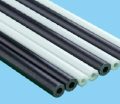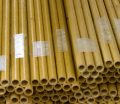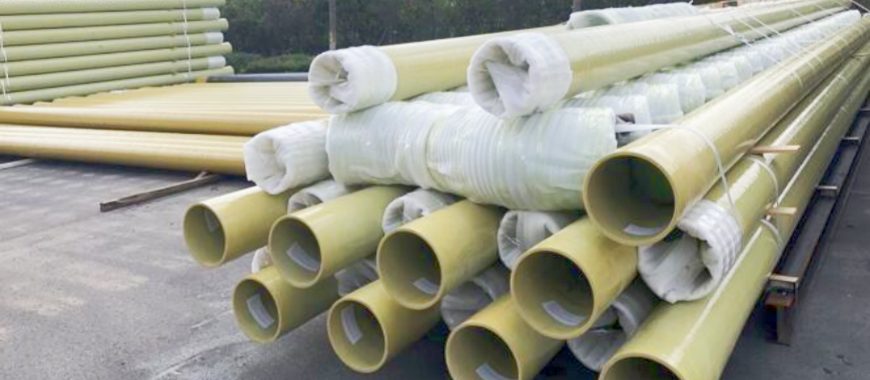
Centrifugally cast fiberglass pipe blends glass fiber, resins and sand for high-strength, corrosion resistance in many applications. The centrifugal casting process for centrifugally cast fiberglass pipe involves rotating a mold at high speeds while molten material is poured in, ensuring uniform distribution and thickness. This method is particularly effective for producing pipes that need to withstand high pressure and harsh environments. Centrifugally cast fiberglass pipe plays a significant role in various industries, including construction, marine, and sewage systems. In construction, centrifugally cast fiberglass pipe is used for structural supports due to its strength and lightweight properties. In marine applications, its corrosion resistance is essential, especially in saltwater environments. Additionally, in sewage systems, centrifugally cast fiberglass pipe provides durability and resistance to chemicals, making it a reliable choice for long-lasting infrastructure solutions in challenging environments.
Simplifying Your Life: Key Functionalities
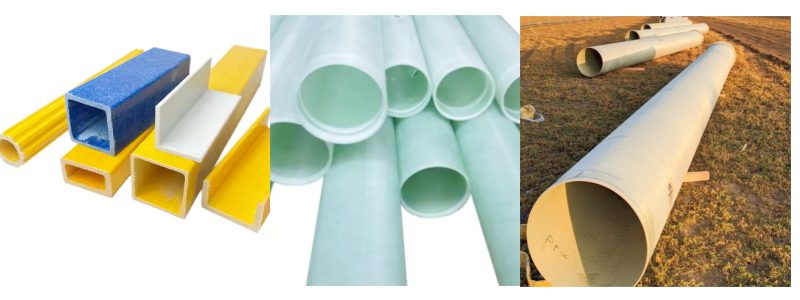
| Attribute Name | Attribute Value |
|---|---|
| Product Name | Centrifugally Cast Fiberglass Pipe |
| Brand Name | GangLong Fiberglass |
| Place of Origin | Hebei, China |
| Application | Drainage, Ventilation, Infrastructure, High Voltage, Fiberglass Mesh Raw Materials |
| Technique | Centrifugal Casting Process, Winding Filament Roving |
| Material | Fiberglass Reinforced Plastic (FRP), ECR Glass |
| Surface Treatment | Smooth, PVC Coated |
| Processing Services | Cutting, Welding, Bending, Moulding, Filament Winding, Spray Up Process |
| Color | Customized Colors (Green, Blue, Gray, Red, White) |
| Shape | Customizable Shapes (Round, Rectangular, Section Bar, Solid Round) |
| Size | Customized Dimensions |
| Features | High Strength, Corrosion Resistance, Dielectric Properties, Insulation Support, Compression Resistance, Fire Prevention,Anti-Corrosion |
| Density | 1.7-1.9g/cm³ |
| Certifications | ISO, IEC, NEMA |
| MOQ | 10pcs |
| Sample Availability | Available |
| Packaging Details | Carton, Pallet, Covered with Wood Plate |
| Standard | IEC, NEMA |
What Is Centrifugally Cast Fiberglass Pipe
Centrifugally Cast Fiberglass Pipe is made using a specialized manufacturing process called centrifugal casting. This process involves spinning a mold at high speeds while adding fiberglass and resin to form the pipe. The centrifugal force ensures even material distribution, resulting in a pipe with uniform thickness and enhanced strength.
Key Features
High Strength and Durability
Centrifugally cast fiberglass pipes offer excellent strength and durability due to the uniform distribution of materials. The fiberglass reinforcement combined with resin provides enhanced tensile strength, making the pipes resistant to mechanical stress and external pressures. This durability ensures long-term performance, even in harsh industrial environments, where other materials like metal or plastic may fail more quickly.
Corrosion and Abrasion Resistance
One of the standout features of centrifugally cast fiberglass pipes is their exceptional resistance to corrosion and abrasion. The fiberglass and resin composition creates a pipe that can withstand exposure to aggressive chemicals, saltwater, and other corrosive substances without degrading. This resistance makes these pipes ideal for applications in industries like oil and gas, chemical processing, and wastewater management.
Temperature and Pressure Tolerance
Centrifugally cast fiberglass pipes demonstrate superior resistance to extreme temperatures and pressures. These pipes can handle both high and low temperatures, making them suitable for transporting hot or cold fluids. Additionally, they can endure high-pressure environments, which are common in industrial applications such as water treatment plants and sewage systems, without compromising structural integrity.
Lightweight and Easy to Handle
Despite their high strength, centrifugally cast fiberglass pipes are lightweight, which makes transportation and installation easier and more cost-effective. Their reduced weight minimizes the need for heavy machinery during installation, leading to faster setup times and lower labor costs. This feature is especially beneficial for projects in remote or difficult-to-access locations.
Advanced Production Technologies and Innovations
Automated Production for High Precision
Modern centrifugal casting uses automated controls to ensure precise layering, which guarantees uniform wall thickness and optimizes strength. This precision is essential for industries where reliability and safety standards are strict, such as in aviation fuel systems or pharmaceutical manufacturing.
Hybrid Material Combinations
Some centrifugally cast fiberglass pipes are now being produced with hybrid materials, combining fiberglass with other reinforcements or resins to enhance specific properties like UV resistance, impact resistance, or flexibility. This customization enables engineers to select pipes tailored exactly to their needs.
Emerging Eco-Friendly Resins
The development of bio-resins and recycled content in fiberglass composites is making CCFRP an even more sustainable choice. As manufacturers incorporate eco-friendly materials, these pipes offer an option for companies and municipalities looking to reduce their environmental footprint.
Quality Testing and Monitoring
During production, centrifugally cast fiberglass pipes undergo rigorous testing, often including ultrasonic or radiographic inspections to identify any inconsistencies. This extensive quality assurance process ensures pipes meet or exceed industry standards, giving them a level of reliability that few other materials can match.
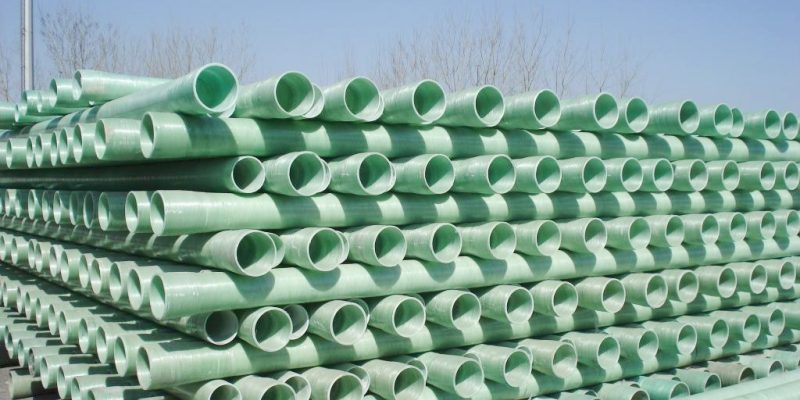
Centrifugally Cast Fiberglass Pipe: Stiffness and Pressure Classes
Centrifugally cast fiberglass pipes (CCFRP) are classified into different stiffness and pressure classes to meet various application requirements, especially in industries with strict specifications for structural integrity and fluid dynamics. These classifications help in selecting pipes suitable for specific environments, load capacities, and pressure needs.
Stiffness Classes
The stiffness of a centrifugally cast fiberglass pipe refers to its ability to resist deformation under external loads, such as soil or water pressure. Engineers classify stiffness by the pipe’s deflection under a specified load. This measurement is crucial for applications where the pipe will be buried underground or subjected to high external pressure. Standard stiffness classes often express stiffness in terms of stiffness modulus (usually in N/m² or psi), indicating the pipe’s resistance to deflection.
- Low-Stiffness Class: Suitable for installations with minimal external loads, such as pipes in areas with low soil cover or above-ground applications. These are generally lighter and more flexible but are not suitable for heavy loads or deep installations.
- Medium-Stiffness Class: Used in environments with moderate soil cover and external loads, such as municipal water and sewer systems where the pipes are buried but not at extreme depths.
- High-Stiffness Class: Designed for high-load environments where pipes face significant external pressures. These pipes are typically used in areas with heavy soil cover, deep installations, or where ground traffic loads are expected (such as under roads or highways).
The stiffness rating can vary based on factors like pipe diameter, wall thickness, and material composition, all of which can be adjusted during the centrifugal casting process.
Pressure Classes
Pressure classes for CCFRP indicate the pipe’s ability to withstand internal pressure, measured in terms of the maximum allowable pressure the pipe can handle. This is essential for applications involving pressurized fluids, such as potable water systems, chemical transport, or industrial piping where internal pressure is a factor.
- Low-Pressure Class: Designed for applications with minimal internal pressure, such as gravity-fed sewer lines or drainage systems where there is little to no pressure exerted by the fluid.
- Medium-Pressure Class: Suitable for general-purpose water distribution, wastewater systems, and industrial applications with moderate internal pressures.
- High-Pressure Class: Applications for this grade are similar to high pressure fiberglass pipes, some applications such as pressurized water mains, industrial chemical transport, and oil & gas pipelines where fluid pressure is high. These pipes are designed to handle sustained high pressures without compromising structural integrity.
How Stiffness and Pressure Classes Affect Application Choices
- Buried Applications: In underground installations, both stiffness and pressure class are crucial. For example, a sewer system in an urban area may require high stiffness to handle soil and traffic loads and low to medium pressure for gravity flow.
- Corrosive Environments: High-pressure, high-stiffness CCFRP pipes are often chosen for corrosive environments like chemical processing plants. Here, the corrosion resistance of fiberglass complements the pressure tolerance required for safely handling pressurized fluids.
- Long-Distance Fluid Transport: In pipelines transporting water or chemicals over long distances, selecting the appropriate pressure class is essential to prevent leaks and maintain efficiency, while stiffness helps the pipeline resist environmental stresses along its path.
Industry Standards and Testing
The stiffness and pressure classes are generally guided by industry standards, such as ASTM and ISO specifications, which outline testing protocols to determine the pressure and stiffness ratings. These tests simulate the conditions the pipe will face, such as internal and external loads, to ensure safety and performance under operational conditions.
Understanding stiffness and pressure classes is essential for choosing the correct centrifugally cast fiberglass pipe. Matching the pipe’s specifications to the operational environment ensures long-term durability, safety, and performance across a wide range of applications.
Maintaining R-Value in Compressed Fiberglass Insulation
The Construction and Specifications of Centrifugally Cast Fiberglass Pipe
The construction and specifications of centrifugally cast fiberglass pipes (CCFRP) involve a precise process and a unique composite material composition that results in a durable, corrosion-resistant pipe.
Specifications of Centrifugally Cast Fiberglass Pipes
Wall Thickness and Diameter
Engineers can customize wall thickness and diameter based on application needs. Thicker walls provide higher pressure ratings and stiffness. Larger diameters suit applications requiring high flow rates. Typical diameters range from a few inches to several feet, depending on industry standards and requirements.
Stiffness and Pressure Ratings
CCFRP pipes are classified into stiffness and pressure classes that determine their suitability for various environments. Stiffness classes are based on the pipe’s ability to resist deflection under load, while pressure classes indicate the maximum allowable internal pressure. These specifications are essential for underground installation or pressurized fluid transport.
Chemical Resistance
The choice of resin is tailored to the application environment. Polyester and vinyl ester resins provide excellent resistance to chemicals, acids, and salts, making the pipes ideal for corrosive environments. This resistance is a key specification in industries like wastewater treatment, chemical processing, and marine applications.
Temperature Resistance
Fiberglass pipes can handle a wide range of temperatures, depending on the type of resin used. Typical temperature resistance ranges from -40°F to 200°F (-40°C to 93°C), with specialized resins extending the range even further. Temperature resistance is crucial for applications in both hot and cold environments, including geothermal systems and refrigeration.
UV and Abrasion Protection
For outdoor applications, a UV-resistant coating may protect the pipe from sunlight degradation. Abrasion-resistant outer layers can protect the pipe from wear in high-traffic areas or when exposed to abrasive materials.
Key Advantages of Centrifugally Cast Fiberglass Pipe Specifications
- Uniform Wall Thickness and High Density: The centrifugal casting process ensures that pipes have a uniform wall thickness and high density, which enhances their durability, leak resistance, and performance under pressure.
- Customizable Specifications: Customizable specifications allow engineers to select pipes suited to each project’s requirements. They can customize wall thickness, diameter, stiffness, and pressure ratings.
- Long Service Life: The corrosion-resistant properties of fiberglass and resin give CCFRP pipes a long service life, even in harsh conditions. This makes them a cost-effective option for applications like municipal water systems, industrial waste, and chemical transport.
Common Applications and Corresponding Specifications
- Municipal Water and Sewer Systems: These applications typically require large-diameter pipes with high stiffness to handle soil loads and moderate pressure ratings to accommodate flow rates.
- Chemical Processing Plants: High-pressure, chemical-resistant pipes are specified, often with vinyl ester resin to resist strong acids and alkalis.
- Marine and Offshore: Engineers use saltwater and abrasion-resistant pipes with UV protection. They select specific diameters and pressure ratings suitable for underwater conditions.
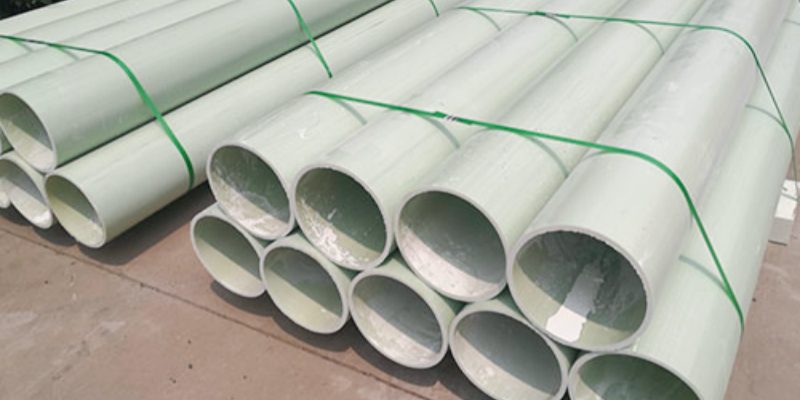
The Key of Centrifugal Casting Process in Fiberglass Pipe Production
GangLong Fiberglass’s Advanced Centrifugal Casting Technology
At GangLong Fiberglass, we utilize advanced centrifugal casting technology to produce high-quality fiberglass pipes. By controlling all parameters of the casting process with state-of-the-art equipment, we ensure precision and consistency in every batch. To verify that our pipes meet or exceed industry standards, we conduct rigorous testing. Designed for high performance, durability, and safety, our pipes are reliable in demanding environments like sewage systems and chemical plants.
The Key Materials Used in Centrifugally Cast Fiberglass Pipes
Centrifugally cast fiberglass pipes consist of glass fibers, resin, and sand. These materials work together to ensure high performance, strength, and durability. Glass fibers offer tensile strength, resistance to corrosion, and mechanical stability. Resin binds the fibers, providing structure and chemical resistance. Sand layers add stiffness and increase strength, enhancing the pipe’s ability to resist external pressures. The combination of these materials results in highly durable pipes for industrial use. Similarly, fiberglass hand lay-up is another manufacturing method that uses a combination of resin and fiberglass to create durable structures, offering flexibility for custom applications.
Glass Fibers
Glass fibers reinforce centrifugally cast fiberglass pipes, providing significant FRP pipe tensile strength. They help the pipes resist internal and external pressures. The fibers also offer excellent corrosion resistance, which is crucial for pipes used in chemical plants and water treatment facilities. Glass fibers ensure that the pipes can handle mechanical stresses without failing. This reinforcement improves the overall durability and longevity of the pipe in demanding applications.
Resin
Resin serves as the binder in centrifugally cast fiberglass pipes, holding the glass fibers together. It also gives the pipe its shape and structural integrity. The type of resin used can vary based on the application, such as polyester, vinyl ester, or epoxy. Each resin type offers unique benefits, like chemical resistance, thermal stability, and enhanced mechanical properties. The resin plays a key role in the pipe’s ability to withstand harsh environments.
Sand
Sand is added in layers between the resin and fiberglass to improve the pipe’s strength and stiffness. This sand layer enhances the pipe’s resistance to external pressures, making it suitable for deep underground installations. It also contributes to the pipe’s durability by increasing its resistance to abrasion and wear. The sand helps create a robust and durable structure, ideal for applications exposed to external forces or harsh environmental conditions.
Construction Process of Centrifugally Cast Fiberglass Pipes
The construction of centrifugally cast fiberglass pipes involves a carefully controlled and precise series of steps to ensure the highest quality product.
Material Preparation
The construction process begins with selecting and preparing the raw materials. The fiberglass reinforcement is chosen for the required strength, while the resin matrix is selected for its chemical resistance and thermal properties. The fiberglass is cut to the desired size and combined with the resin, often a thermosetting polymer like epoxy or polyester. This mixture ensures a consistent and even distribution during the casting process.
Mold Setup and Spinning
The cylindrical mold is set up and positioned horizontally, typically made from a durable metal material. The mold rotates at high speeds while the fiberglass and resin mixture is introduced. The centrifugal force generated by the spinning action spreads the materials evenly across the mold’s inner surface, forming a compact, dense pipe wall. The spinning action ensures a consistent and uniform structure.
Layering and Curing
The pipe is constructed in layers, with each layer of resin and fiberglass reinforcing the pipe’s strength. The first layer is a resin-rich inner liner designed for chemical resistance, followed by layers of fiberglass-reinforced resin to enhance the pipe’s structural integrity. Additional layers may be added, depending on the required pipe thickness and pressure ratings. After building up the layers, the pipe undergoes curing. The curing process hardens the resin, solidifying the structure and ensuring its stability.
Demolding and Final Processing
Once the pipe has been fully cured, it is removed from the mold. The pipe is then inspected and finished, with the ends often trimmed and smoothed. Some pipes may receive additional coatings, such as UV-resistant or abrasion-resistant layers, depending on the specific application requirements. The pipes undergo quality testing to ensure they meet the necessary standards for strength, chemical resistance, and pressure tolerance.
Advantages of the Centrifugal Casting Process
The centrifugal casting process used in manufacturing centrifugally cast fiberglass pipes offers several advantages over traditional methods like hand lay-up or filament winding. In comparison, the GRP FRP pipe filament winding machine provides an automated approach for creating fiberglass pipes by winding layers of resin and glass fibers, offering precise control over the pipe’s strength and structure. This method is ideal for producing pipes with specific performance characteristics, complementing the benefits of centrifugal casting in certain applications.
- Uniform Wall Thickness: One of the main benefits of centrifugal casting is the even distribution of materials within the mold, resulting in uniform wall thickness. This is critical for maintaining consistent performance throughout the length of the pipe, particularly in applications where internal and external pressures fluctuate.
- Increased Strength and Durability: The high-density structure created by centrifugal force enhances the strength of the pipe, allowing it to withstand extreme conditions. Centrifugally cast fiberglass pipe is known for its ability to handle high internal pressures without compromising its integrity.
- Corrosion Resistance: The use of glass fibers and specialized resins in the production of centrifugally cast fiberglass pipe ensures excellent resistance to corrosion, even when exposed to harsh chemicals, saltwater, or other corrosive substances. This makes these pipes ideal for industries such as wastewater treatment, desalination plants, and chemical processing.
- Lightweight: Despite its strength, centrifugally cast fiberglass pipe is relatively lightweight compared to other materials like steel or concrete. This reduces transportation costs and simplifies installation, particularly in remote or hard-to-access locations.
Key Fiberglass Insulation Manufacturers Leading the Market
Key Benefits of Centrifugally Cast Fiberglass Pipe
Centrifugally cast fiberglass pipes stand out in industrial applications due to their strength, corrosion resistance, and lightweight nature. These pipes provide exceptional performance compared to traditional materials like steel, concrete, and PVC. Their unique combination of materials, manufacturing process, and performance characteristics make them ideal for diverse environments, including sewage systems, chemical plants, and large-scale infrastructure projects. Additionally, thick wall fiberglass tube are often used in applications requiring extra strength and durability, offering enhanced resistance to internal and external pressures in demanding environments.
Strength and Durability
Centrifugally cast fiberglass pipes offer a high strength-to-weight ratio. They are much lighter than steel or concrete pipes, making them easier to transport and install. Despite their lighter weight, these pipes can withstand heavy loads, high pressures, and extreme environmental conditions. The durability of fiberglass pipes ensures a long service life, reducing the need for frequent replacements and maintenance.
Corrosion Resistance
Fiberglass pipes provide excellent resistance to corrosion, unlike steel, which rusts over time. This makes them suitable for harsh environments exposed to moisture, chemicals, and UV radiation. The pipes are ideal for use in sewage systems, marine applications, and chemical plants. Their corrosion resistance ensures they remain intact for a long time, minimizing maintenance and replacement costs.
Economic and Environmental Benefits
Although the initial investment in fiberglass pipes can be higher, they offer long-term economic advantages. The durability and low maintenance costs reduce overall project expenses. The lightweight nature of these pipes also cuts transportation and installation costs, requiring less heavy equipment and labor. Environmentally, the long lifespan of fiberglass pipes minimizes waste, and their production process has a lower carbon footprint than metal pipes.
Flexibility in Design
Centrifugally cast fiberglass pipes are highly customizable in terms of diameter, length, and wall thickness. This design flexibility makes them suitable for a variety of applications, from small-scale projects to large industrial installations. At GangLong Fiberglass, we offer extensive customization options to meet specific project requirements, ensuring our pipes fit perfectly into any infrastructure.
Suitability for Sewage Systems
Centrifugally cast fiberglass pipes are especially beneficial for sewage systems due to their corrosion resistance and smooth inner surfaces. These pipes reduce friction and improve flow efficiency, decreasing the risk of blockages and enhancing the transport of wastewater. Their resistance to chemical attacks and UV radiation further contributes to their reliability and long lifespan, making them an ideal choice for municipal sewage systems.
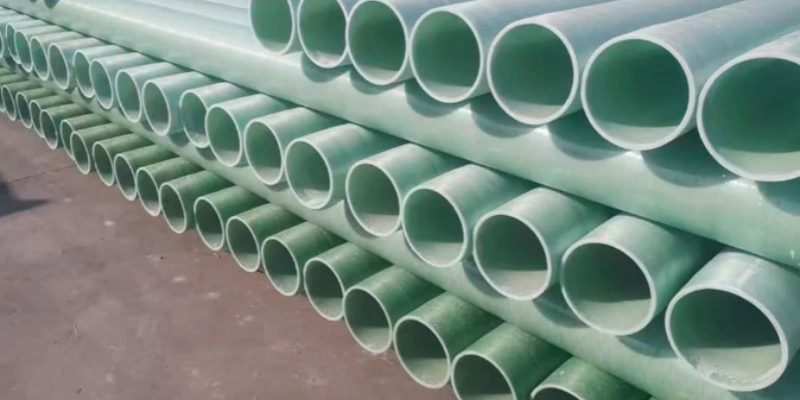
Applications of Centrifugally Cast Fiberglass Pipe
Centrifugally cast fiberglass pipes offer an exceptional combination of strength, durability, and resistance to environmental factors, making them suitable for a variety of demanding industries. Their versatility and long-lasting performance make them an ideal choice for applications where traditional materials may fall short. Additionally, large diameter fiberglass pipe are particularly useful in projects requiring the transport of high volumes of fluid, offering enhanced strength and resistance to corrosion in large-scale applications. Below is an expanded overview of some key applications where these pipes are utilized:
Desalination Plants
Desalination facilities, which require pipes to resist the corrosive effects of saltwater and handle high-pressure conditions, benefit greatly from the use of centrifugally cast fiberglass pipes. These pipes are well-suited for the harsh operating environments of desalination processes, including reverse osmosis. Their durability and minimal maintenance needs help ensure a continuous, reliable operation, crucial in water-scarce regions that depend on desalinated water.
Oil and Gas Industry
In the oil and gas industry, centrifugally cast fiberglass pipes are often used to transport crude oil, natural gas, and other hydrocarbons. The pipes’ chemical resistance and ability to withstand high pressures make them suitable for such demanding applications. Their durability in extreme environments ensures that they remain intact and functional throughout their service life, reducing the need for frequent maintenance and lowering operational costs.
Industrial Cooling Systems
Many industrial facilities rely on large-scale cooling systems to maintain equipment at optimal temperatures. Centrifugally cast fiberglass pipes are perfect for these applications due to their ability to withstand extreme temperatures and pressure fluctuations. They are commonly used in power plants, chemical processing facilities, and other industries requiring efficient cooling systems that perform reliably over time.
Marine Applications
In marine environments, saltwater corrosion can quickly degrade metal pipes, making them unsuitable for many applications. However, centrifugally cast fiberglass pipes are resistant to the corrosive effects of saltwater, making them the preferred choice for marine infrastructure. These pipes are used in boat construction, docks, and other marine systems, ensuring long-term durability and reducing maintenance costs in challenging environmental conditions.
Sewer Systems and Industrial Pipelines
Centrifugally cast fiberglass pipes are commonly used in sewer systems due to their exceptional resistance to corrosion from wastewater and chemicals. Unlike concrete or steel pipes, which are prone to deterioration, fiberglass pipes maintain their integrity over time, ensuring a longer service life and reduced maintenance costs. In industrial pipelines, these pipes are used to transport chemicals, gases, and wastewater under extreme conditions such as high pressures, elevated temperatures, and aggressive chemical environments. Their combination of strength and chemical resistance makes them ideal for these demanding applications.
Large-Scale Industrial and Municipal Applications
Centrifugally cast fiberglass pipes are the material of choice for large-scale industrial and municipal applications that require high-performance solutions. Whether used in municipal drainage systems, industrial wastewater treatment plants, or desalination facilities, these pipes offer the strength and durability necessary to handle extreme conditions. Their ability to perform reliably in demanding environments makes them a preferred choice for critical infrastructure projects.
Where to Use Vinyl Backed Fiberglass Insulation in Construction
FAQs about Centrifugally Cast Fiberglass Pipe
Fiberglass Reinforced Thermosetting Pipe Material (FRP) is a composite made from a polymer matrix reinforced with glass fibers. Thermosetting means the resin cures into a rigid structure that cannot melt again, ensuring durability. FRP pipes resist corrosion, chemicals, and extreme temperatures, making them ideal for industrial applications like chemical processing, oil and gas, wastewater management, and power generation. The fiberglass reinforcement provides strength, while the thermosetting resin matrix ensures durability and resistance. FRP pipes are lightweight, making installation easier and more cost-effective. They are also non-conductive, adding safety in electrical insulation applications. GangLong Fiberglass offers advanced FRP pipes that meet industries’ needs for long-lasting, low-maintenance solutions.
Fiberglass pipes have gained popularity across industries for their strength, durability, and corrosion resistance. These pipes often replace traditional metal pipes, which can rust or deteriorate in environments with chemicals, saltwater, or extreme weather. Common uses include chemical processing plants, water and sewage treatment facilities, marine infrastructure, and oil and gas industries. Their lightweight nature makes fiberglass pipes easier to install and transport than metal alternatives. They also require minimal maintenance, reducing long-term operational costs. Additionally, fiberglass pipes are non-conductive, making them ideal for electrical insulation. GangLong Fiberglass offers a range of fiberglass pipes designed for demanding environments, ensuring long-lasting performance and reliability. Their versatility makes fiberglass pipes essential in modern infrastructure and industrial systems.
The purpose of centrifugal casting is to produce cylindrical or tubular components by rotating a mold at high speeds while pouring molten material into it. The centrifugal force pushes the material against the mold walls, creating dense, uniform, and defect-free parts, such as pipes, tanks, and various components with a smooth, consistent surface and excellent structural integrity.
The three types of centrifugal casting are:
True Centrifugal Casting: Used for creating cylindrical parts, where the mold rotates horizontally or vertically to produce pipes, cylinders, and other hollow components.
Semi-Centrifugal Casting: In this type, the mold partially rotates, producing parts with thicker walls and solid or near-solid shapes, like wheels and pulleys.
Centrifuge Casting (Centrifugal Die Casting): This process is used to create smaller, detailed cast parts by rotating molds at high speeds, ideal for intricate designs and smaller components.
A centrifugally cast pipe is produced using the centrifugal casting process. Molten material (usually metals or fiberglass) pours into a rotating mold. The centrifugal force distributes the material uniformly around the mold walls. This creates a pipe with a dense, defect-free structure and enhanced mechanical properties. This method suits pipes that require high durability and uniformity.
Advantages of Fiberglass Pipes:Corrosion Resistance: Fiberglass pipes are highly resistant to corrosion from chemicals, water, and environmental exposure, making them ideal for harsh conditions.
Lightweight: They are lighter than many metal pipes, reducing transportation and installation costs.
High Strength-to-Weight Ratio: Fiberglass offers excellent strength without adding significant weight, suitable for high-pressure applications.
Low Maintenance: These pipes have a long lifespan and require minimal maintenance, reducing operational costs over time.
Smooth Internal Surface: The smooth interior reduces friction losses, enhancing flow efficiency and minimizing sediment buildup.
Disadvantages of Fiberglass:Brittleness: Fiberglass can be brittle and prone to cracking or breaking under sudden impact or excessive flexing.
UV Degradation: Prolonged exposure to UV radiation can weaken fiberglass, requiring UV-resistant coatings for outdoor applications.
Limited Temperature Tolerance: Fiberglass may degrade at high temperatures, making it unsuitable for applications with extreme heat.
Higher Initial Cost: Although fiberglass has low maintenance costs, its initial cost can be higher compared to traditional materials like PVC.
Health Hazards: During installation or repair, fiberglass fibers can be hazardous to health if inhaled, necessitating safety precautions for workers.

As the editor of GangLong Fiberglass, I have years of experience and in-depth research, focusing on cable tray products, fiberglass solutions, and grille systems. I incorporate years of industry insights and practical experience into every content, committed to promoting the progress of the industry. At GangLong Fiberglass, my commitment is reflected in every product, from innovative cable trays to durable fiberglass solutions and sturdy grille systems. As an authoritative voice in the industry, my goal is to provide valuable information to professionals and businesses and promote forward-looking solutions.

